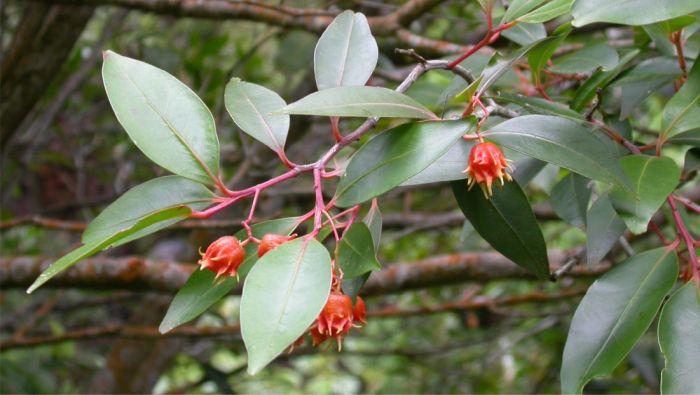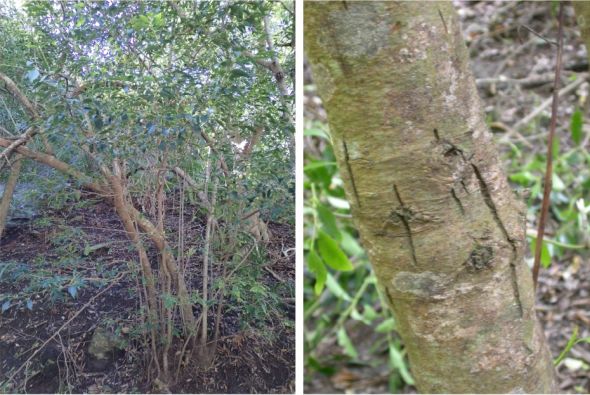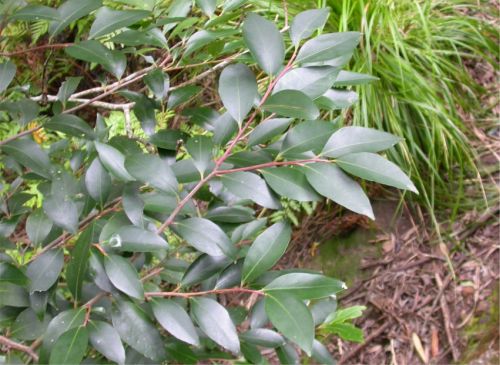Pterocelastrus rostratus
Pterocelastrus rostratus (Thunb.) Walp.
Family: Celastraceae
Common names: red cherrywood, beaked pterocelastrus, red candlewood (Eng.); rooikershout, kersiehout (Afr.); ugobandlovu, usahlulamanye (Zulu); itywina (Xhosa)
Introduction
A graceful evergreen tree, or shrub, with a slender stem, a bushy crown and sweet-scented flowers in summer followed by distinctive spiky, orange to reddish-brown fruits.

Description
Description
Pterocelastrus rostratus is usually a small tree 6-10 m tall, but occasionally reaches up to 20 m, depending on the habitat. The long, elliptic, narrowly tipped leaves have a leathery texture, and are shiny, dark green above, and paler green below, with a bluntly pointed base. The trunk is grey to red-brown and the young, quadrangular branchlets are red. Branched heads of small, dainty, sweet scented, cream to pale brown flowers are formed in the leaf-axils during summer, from October to April. The small, orange, many-horned capsules, covered with coarse, triangular spines become dark reddish-brown when mature. The capsules split open and expose 1-3 small, silvery-brown, egg-shaped seeds from winter to midsummer (July-February).

Conservation Status
Status
Pterocelastrus rostratus is not threatened and is assessed as Least Concern (LC) according SANBI’s Red List of South African Plants. It was assessed as Declining in 2009, due to notable declines in the wild population in Mpumalanga because trees there are ring barked or chopped down for bark harvested for the medicinal plant trade, but the species does not appear to be as severely impacted in the rest of its South African range.

Distribution and habitat
Distribution description
Pterocelastrus rostratus occurs from the Cape Peninsula and Betty’s Bay in the Western Cape, through the Eastern Cape, KwaZulu-Natal, Mpumalanga and Limpopo Provinces in South Africa, and in Eswatini (formerly Swaziland). It grows in moist mountain and in high altitude evergreen forests, on forest margins, in montane scrub and on mountain sides, often in misty areas. It grows between other trees, often intertwined with them.
Derivation of name and historical aspects
History
The genus name is derived from the Greek word pteron, meaning ‘a wing’ and the genus Celastrus, meaning ‘winged celastrus’ and refers to the fruit that has wing-like outgrowths and the resemblance of the plants to the genus Celastrus. The species name rostratus means ‘beaked’ or ‘with a slender point’ and refers to the spiky tips of the horns on the fruit.

Ecology
Ecology
The flowers are pollinated by bees and the seeds are dispersed by birds.
Uses
Use
The bark of Pterocelastrus rostratus contains tannin and is used as traditional medicine to treat respiratory ailments and for a blocked and wheezing chest, and in a mixture to relieve general body pains. The Zulu people used it as a love charm and a sprinkling medicine to chase away evil spirits. Powered bark mixed with other plants and the dried carcass of a fruit bat were used to treat spinal diseases. A 2021 study showed that the bark demonstrates good broad-spectrum antimicrobial activity against respiratory tract pathogens.
Pterocelastrus rostratus bark is heavily harvested for muthi and sold in markets in Gauteng, KwaZulu-Natal and Mpumalanga. Many trees are ring-barked because so much of their bark is removed by the harvesters, which often causes them to die from diseases.

Growing Pterocelastrus rostratus
Grow
This species can be propagated from cuttings and seeds. Collect seeds from midwinter to midsummer (July-February) and take cuttings in autumn, from April to May.
Sow seeds in a mixture of fine-milled sifted bark, coarse river sand and coir. Sow seeds over the surface, lightly cover with sowing medium, water gently and place in a roof-covered area. To enhance germination use smoke treatment. Seeds will take 6-10 weeks to germinate. While in the process of germination, use a light treatment with liquid organic seaweed-based fertilizer. (May-June)
For the stem cuttings, prepare a mixture of milled bark, perlite and coarse river sand and use a rooting hormone powder suitable for hardwood cuttings. Plants will take 3 months to root in greenhouse. Plant the rooted cuttings in a potting mix with added compost, leave for 4 weeks under shade netting to harden off. Feed with a general slow-release fertilizer such as pelletised composted poultry-manure. Plant in well-drained soil in a shaded area.
References
- Bean, A. & Johns, A. 2005. Stellenbosch to Hermanus. South African Wild Flower Guide 5. Botanical Society of South Africa, Cape Town.
- Boon, R. 2010. Pooley's trees of eastern South Africa, a complete guide. Flora & Fauna Publications Trust, Durban.
- Coates Palgrave, K. 1977. Trees of southern Africa. Struik, Cape Town.
- Grace, O.M., Prendergast, H.D.V., Jager, A.K. & Van Staden, J. & Van Wyk, A.E. 2003. Bark medicines used in traditional healthcare in KwaZulu-Natal, South Africa: An inventory. South African Journal of Botany 69(3):301-363.
- Khumalo, G.P., Sadgrove, N.J., Van Vuuren S.F. & Van Wyk, B.-E. 2021. South Africa’s best bark medicines prescribed at the Johannesburg muthi markets for skin, gut and lung infections. Antibiotics (Basel) 10(6):681.
- Manning, J. & Goldblatt, P. 2012. Plants of the Greater Cape Floristic Region 1: the Core Cape Flora. Strelitzia 29. South African National Biodiversity Institute, Pretoria.
- Palmer, E. & Pitman, N. 1972. Trees of southern Africa. Balkema, Cape Town.
- Potgieter, J. 2021. Observation of Pterocelastrus rostratus, Jonkersberg, Western Cape. iNaturalist. Online. https://www.inaturalist.org/observations/86533756.
- Smith, C.A. 1966. Common names of South African plants. Memoirs of the Botanical Survey of South Africa No. 35. Government Printer, Pretoria.
- Trinder-Smith, T.H. 2003. The Levyns Guide to the plant genera of the south western Cape. Bolus Herbarium, UCT, Red Roof Design CC, Cape Town
- Van Wyk, B. & Van Wyk, P. 1997. Field guide to trees of southern Africa. Struik, Cape Town.
- Von Breitenbach, F. 1974. Southern Cape forests and trees. The Government Printer, Pretoria.
- Williams, V.L., Raimondo, D., Crouch, N.R., Cunningham, A.B., Scott-Shaw, C.R., Lötter, M. & Ngwenya, A.M. 2016. Pterocelastrus rostratus (Thunb.) Walp. National Assessment: Red List of South African Plants v. 2020.1. Accessed 2023/08/16.
Credits
Loretta Floors
Harold Porter National Botanical Garden
September 2023
Acknowledgements: the author thanks Ebraime Hull and Leainne Samuels for the propagation information and Jenny Potgieter for making her images of Pterocelastrus rostratus in flower available on iNaturalist.
Plant Attributes:
Plant Type: Shrub, Tree
SA Distribution: Eastern Cape, KwaZulu-Natal, Limpopo, Mpumalanga, Western Cape
Soil type: Sandy, Loam
Flowering season: Spring, Early Summer, Late Summer
PH: Acid, Neutral
Flower colour: Brown, Pink, Cream
Aspect: Morning Sun (Semi Shade), Afternoon Sun (Semi Shade)
Gardening skill: Average
Special Features:
Horticultural zones









Rate this article
Article well written and informative
Rate this plant
Is this an interesting plant?
Login to add your Comment
Back to topNot registered yet? Click here to register.